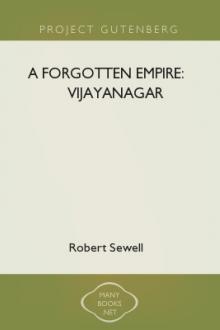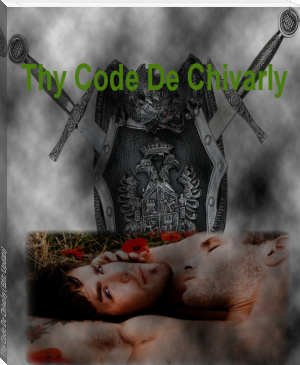A Forgotten Empire: Vijayanagar by Robert Sewell (short story to read TXT) 📕

- Author: Robert Sewell
- Performer: -
Book online «A Forgotten Empire: Vijayanagar by Robert Sewell (short story to read TXT) 📕». Author Robert Sewell
Thus, in or about the year A.D. 1336, sprung into existence the great city which afterwards became so magnificent and of such wide-spread fame.
The chronicle continues by saying that the king constructed in the city of Vijayanagar a magnificent temple in honour of the sage. This temple I take to be the great temple near the river, still in use and known as the temple of Hampi or Hampe, having a small village clustering about it. On the rocks above it, close to a group of more modern Jain temples, is to be seen a small shrine built entirely, roof as well as walls, of stone. Everything about this little relic proves it to be of greater antiquity than any other structure in the whole circuit of the hills, but its exact age is doubtful. It looks like a building of the seventh century A.D. Mr. Rea, superintendent of the Madras Archaeological Survey, in an article published in the MADRAS CHRISTIAN COLLEGE MAGAZINE for December 1886, points out that the fact of mortar having been used in its construction throws a doubt upon its being as old as its type of architecture would otherwise make it appear. It is quite possible, however, that the shrine may have been used by a succession of recluses, the last of whom was the great teacher Madhava. If we stand on that rock and imagine all the great ruins of the city visible from thence, the palaces and temples, the statues and towers and walls, to be swept out of existence, we have around us nothing but Nature in one of her wildest moods — lofty hills near and far, formed almost entirely of huge tumbled boulders of granite, but with trees and grass on all the low ground. It was a lonely spot, separated by the river from the mere inhabited country on the farther side, where dwelt the chiefs of Anegundi, and was just such as would have been chosen for their abode by the ascetics of former days, who loved to dwell in solitude and isolation amid scenes of grandeur and beauty.
We shall, however, in all probability never know whether this hermit, whose actual existence at the time is attested by every tradition regarding the origin of Vijayanagar, was really the great Madhava or another less celebrated sage, on whom by a confusion of ideas his name has been foisted. Some say that Madhavacharya lived entirely at Sringeri.
There are a number of other traditions relating to the birth of the city and empire of Vijayanagar.
One has it that two brothers named Bukka and Harihara, who had been in the service of the king of Warangal at the time of the destruction of that kingdom by the Muhammadans in 1323, escaped with a small body of horse to the hill country about Anegundi, being accompanied in their flight by the Brahman Madhava or Madhavacharya Vidyaranya, and by some means not stated became lords of that tract, afterwards founding the city of Vijayanagar.[29]
Another states that the two brothers were officers in the service of the Muhammadan governor of Warangal subsequent to its first capture in 1309. They were despatched against the Hoysala Ballala sovereign in the expedition under the command of Malik Kafur in 1310, which resulted in the capture of the Hindu capital, Dvarasamudra; but the portion of the force to which the brothers belonged suffered a defeat, and they fled to the mountainous tract near Anegundi. Here they met the holy Madhava, who was living the life of a recluse, and by his aid they established the kingdom and capital city.
A variant of this relates that the two brothers for some reason fled direct from Warangal to Anegundi. This account redounds more to their honour as Hindus. Though compelled first to accept service under their conquerors, their patriotism triumphed in the end, and they abandoned the flesh pots of Egypt to throw in their luck with their co-religionists.
A fourth story avers that the hermit Madhava himself founded the city after the discovery of a hidden treasure, ruled over it himself, and left it after his death to a Kuruba family who established the first regular dynasty.
A fifth, mentioned by Couto,[30] who fixes the date as 1220, states that while Madhava was living his ascetic life amongst the mountains he was supported by meals brought to him by a poor shepherd called Bukka, “and one day the Brahman said to him, ‘Thou shalt be king and emperor of all Industan.’ The other shepherds learned this, and began to treat this shepherd with veneration and made him their head; and he acquired the name of ‘king,’ and began to conquer his neighbours, who were five in number, viz., Canara, Taligas, Canguivarao, Negapatao, and he of the Badagas, and he at last became lord of all and called himself Boca Rao.” He was attacked by the king of Delhi, but the latter was defeated and retired, whereupon Bukka established a city “and called it Visaja Nagar, which we corruptly call Bisnaga; and we call all the kingdom by that name, but the natives amongst themselves always call it the ‘kingdom of Canara.’ ” Couto’s narrative seems to be a mixture of several stories. His wrong date points to his having partly depended upon the original chronicle of Nuniz, or the summary of it published by Barros; while the rest of the tale savours more of Hindu romance than of historical accuracy. He retains, however, the tradition of an attack by the king of Delhi and the latter’s subsequent retirement.
Another authority suggests that Bukka and Harihara may have been feudatories of the Hoysala Ballalas.
Nikitin, the Russian traveller, who was in India in 1474, seems to favour the view that they belonged to the old royal house of the Kadambas of Banavasi, since he speaks of “the Hindoo Sultan Kadam,” who resided at “Bichenegher.”[31]
Here we have a whole bundle of tales and traditions to account for the origin of the great kingdom, and can take our choice. There are many others also. Perhaps the most reasonable account would be one culled from the general drift of the Hindu legends combined with the certainties of historical fact; and from this point of view we may for the present suppose that two brothers, Hindus of the Kuruba caste, who were men of strong religious feeling, serving in the treasury of the king of Warangal, fled from that place on its sack and destruction in 1323 and took service under the petty Rajah of Anegundi. Both they and their chiefs were filled with horror and disgust at the conduct of the marauding Moslems, and pledged themselves to the cause of their country and their religion. The brothers rose to be minister and treasurer respectively at Anegundi. In 1334 the chief gave shelter to Baha-ud-din, nephew of Muhammad of Delhi, and was attacked by the Sultan. Anegundi fell, as narrated by Batuta, and the Sultan retired, leaving Mallik as his deputy to rule the state. Mallik found the people too strong for him, and eventually the Sultan restored the country to the Hindus, raising to be rajah and minister respectively the two brothers who had formerly been minister and treasurer. These were Harihara I. (“Hukka”) and Bukka I.
The First Vijayanagar Dynasty
[The following shows the pedigree of this dynasty as given in the EPIGRAPHIA INDICA (iii. p. 36). Inscriptions not yet satisfactorily examined will probably add to the information given.]
CHAPTER 3
The First Kings (A.D. 1336 to 1379)
Rapid acquisition of territory — Reign of Harihara I. — Check to Muhammadan aggression — Reign of Bukka I. — Kampa and Sangama? — The Bahmani kingdom established, 1347 — Death of Nagadeva of Warangal — Vijayanagar’s first great war — Massacres by Muhammad Bahmani — Battle at Adoni, 1366 — Flight of Bukka — Mujahid’s war, 1375 — He visits the Malabar coast — Siege of Vijayanagar — Extension of territory — Death of Mujahid, 1378.
The city of Vijayanagar, thus founded about the year 1335, speedily grew in importance and became the refuge of the outcasts, refugees, and fighting men of the Hindus, beaten and driven out of their old strongholds by the advancing Muhammadans.
The first rulers of Vijayanagar, however, did not dare to call themselves kings, nor did even the Brahmans do so who composed the text of their early inscriptions. It is for this reason that I have spoken of Harihara I. and Bukka I. as “Chiefs.” The inscription referred to of Harihara in 1340 calls him “Hariyappa VODEYA,” the former name being less honourable than “Harihara,” and the latter definitely entitling him to rank only as a chieftain. Moreover, the Sanskrit title given him is MAHAMANDALESVARA, which may be translated “great lord” — not king. And the same is the case with his successor, Bukka, in two inscriptions,[32] one of which is dated in 1353. Already in 1340 Harihara is said to have been possessed of very large territories, and he was the acknowledged overlord of villages as far north as the Kaladgi district, north of the Malprabha, a country that had been overrun by Muhammad Taghlaq. That this was not a mere empty boast is shown by the fact that a fort was built in that year at Badami by permission of Harihara.
And thus we see the first chief of Vijayanagar quietly, and perhaps peacefully, acquiring great influence and extensive possessions. These so rapidly increased that Bukka’s successor, Harihara II., styles himself RAJADHIRAJA, “king of kings,” or emperor.
But to revert to the first king Harihara, or, as Nuniz calls him, “Dehorao,” for DEVA RAYA. He reigned, according to our chronicle, seven years, “and did nothing therein but pacify the kingdom, which he left in complete tranquillity.” His death, if this be so, would have taken place about the year 1343. Nuniz relates that he founded a temple in honour of the Brahman hermit, his protector. This was the great temple at Hampe close to the river, which is still in full preservation and is the only one among the massive shrines erected at the capital in which worship is still carried on; the others were remorselessly wrecked and destroyed by the Muhammadans in 1565. As already stated, the traveller Ibn Batuta refers to this king under the name of “Haraib” or “Harib” in or about the year 1342. If the traditions collated by Nuniz, according to which Harihara I. lived at peace during the seven years of his reign, be true, his death must have occurred before 1344, because in that year, as we learn from other sources, Krishna, son of Pratapa Rudra of Warangal, took refuge at Vijayanagar, and, in concert with its king and with the surviving Ballala princes of Dvarasamudra, drove back the Muhammadans, rescued for a time part of the Southern Dakhan country, and prepared the way for the overthrow of the





Comments (0)